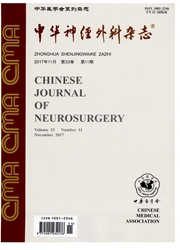

 中文摘要:
中文摘要:
目的探讨颈静脉孔区脊索瘤的临床特点和手术疗效。方法回顾性分析16例颈静脉孔区脊索瘤患者的临床资料并进行随访。结果16例颈静脉孔区脊索瘤患者中,主要表现为后组脑神经麻痹症状(12例)。手术主要采用枕下远外侧经髁入路(10例),肿瘤全切5例,次全切10例,大部切除1例,病理软骨型为主(11例),术后3例接受放射治疗,随访到的13例患者有症状者仍以后组脑神经功能障碍为主(7例)。结论颈静脉孔区脊索瘤患者临床症状以后组脑神经麻痹症状为主,病理类型以软骨型多见,选择合适的手术入路,术中注意脑神经功能的保护是手术成功的关键,术后根据情况辅以放疗可获得良好的结果。
 英文摘要:
英文摘要:
Objective To analysis the clinical characteristics, surgical treatment and outcome of chordoma iri the jugular foramen area. Methods The author retrospectively studied data from 16 patients with chordoma in the jugular foramen area who had undergone surgeries in the department of skullbase and brain stem of Beijing Tiantan Hospital between January 2006 and June 2011, and follow-up was performed through recheck in out-patient department, telephone and letter. Results There are 8 females and 8 males in this group and all of them underwent surgical procedures. The mean age is 39-year-old and the mean symptomatic history time was 18. 3 months. The main clinical presentation is paralysis of the lower cranial nerves (IX, X and XI, 12 cases), 6 patients also suffered from deficits in cranial nerve vm, other presentations are deficits in eyesight (4 cases), ataxia (3 cases), numbness of limbs ( 2 cases), facial paralysis (2 cases) and deficits of abducent nerve ( 1 case). Far lateral approach was used in 10 cases, retrosigmoidsuboccipital approach was used in 2 cases, infratemporal trans-tentorium of cerebellum approach in 2 cases and expanded middle cranial fossa approach in 2 cases. Gross total removal was achivevd in 5 cases, subtotal removal in 10 cases and partial resection 1 case. The pathologic type of 5 cases in this group is typical chordoma, and other 11 cases are chondroid chordoma. Follow-up revealed obvious improvement in 5 cases, permanent paralysis of the lower cranial nerves in 7 cases and facial paralysis in 1 case. Conclusions The main clinical presentation of patients with jugular foramen chordoma is paralysis of the lower cranial nerves and the main pathology of the chordoma in this area is chondroid type, choosing an appropriate approach and the protection of lower cranial nerve are important for a good prognosis.
 同期刊论文项目
同期刊论文项目
 同项目期刊论文
同项目期刊论文
 期刊信息
期刊信息
